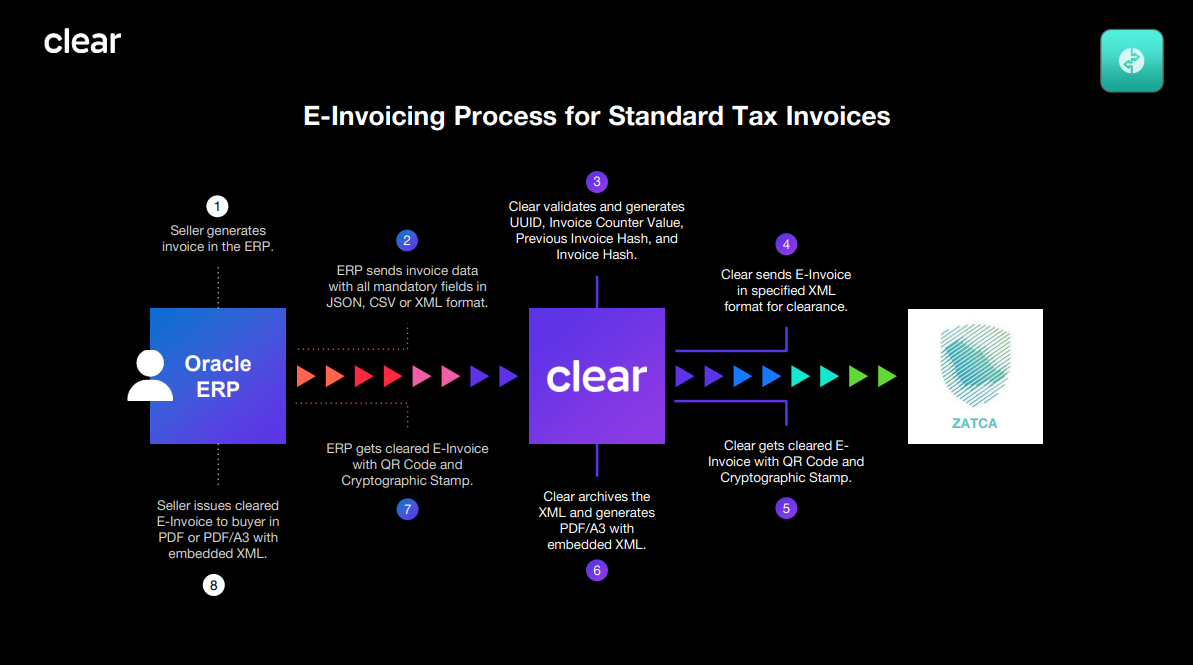RELATED ARTICLES
- E-Invoicing in Saudi Arabia
- ZATCA e-Invoicing Phase 2: Applicability, Requirements, Rules and Regulations in Saudi Arabia
- ZATCA Announced Wave 2 Under Phase 2 of e-Invoicing in Saudi Arabia
- ZATCA Announced Wave 3 Under Phase 2 of Saudi Arabia e-Invoicing
- ZATCA Announced Wave 4 Under Phase 2 of Saudi Arabia e-Invoicing
- ZATCA Announced Wave 5 Under Phase 2 of Saudi Arabia e-Invoicing
- ZATCA Announced Wave 6 Under Phase 2 of Saudi Arabia e-Invoicing
- ZATCA Announced Wave 1 Under Phase 2 of e-Invoicing in Saudi Arabia
- How to Validate ZATCA e-Invoice Using QR Code?
- FAQs on Phase 2 of KSA e-Invoicing
- ZATCA Announced Wave 7 Under Phase 2 of Saudi Arabia e-Invoicing
- ZATCA Announced Wave 8 Under Phase 2 of Saudi Arabia e-Invoicing
- KSA VAT Number Verification: How to Verify a VAT Number in Saudi Arabia?
- Impact of ZATCA e-Invoicing on Saudi Arabia Businesses
- ZATCA Announced Wave 9 Under Phase 2 of Saudi Arabia e-Invoicing
- ZATCA Announced Wave 10 Under Phase 2 of Saudi Arabia e-Invoicing
- ZATCA Announced Wave 11 Under Phase 2 of Saudi Arabia e-Invoicing
- ZATCA Announced Wave 12 Under Phase 2 of Saudi Arabia e-Invoicing
How to Integrate Oracle EBS with ZATCA?
The Saudi tax authority, Zakat, Tax and Customs Authority (ZATCA), implements e-invoicing in phases. Accordingly, ZATCA implemented phase 1 on 4th December 2021 and started phase 2 in waves from 1st January 2023. Also, it clarified that the businesses will be categorised and notified about phase 2 at least six months before their wave.
Accordingly, it announced the following waves:
- Wave 1 under phase 2: Taxpayers with SAR 3 billion or more turnover in 2021 fall under wave 1 from 1st January 2023.
- Wave 2 under phase 2: Businesses registered under Saudi Value Added Tax (VAT) with more than SAR 500 million and less than SAR 3 billion turnover in 2021 fall under wave 2 from 1st July 2023.
- Wave 3 under phase 2: Saudi businesses having more than SAR 250 million and less than SAR 500 million turnover in 2021 or 2022 fall under wave 3 w.e.f 1st October 2023.
- Wave 4 under phase 2: Saudi taxpayers having a turnover of more than SAR 150 million and less than SAR 250 million in 2021 or 2022 fall under wave four from 1st November 2023.
- Wave 5 under phase 2: Taxpayers registered under VAT having more than SAR 100 million and less than SAR 150 million turnover in 2021 or 2022 must integrate with the Fatoora portal w.e.f 1st December 2023.
- Wave 6 under phase 2: Saudi taxpayers with more than SAR 70 million and less than SAR 100 million turnover in 2021 or 2022 shall integrate with ZATCA’s Fatoora portal w.e.f 1st January 2024.
Hence, the applicable businesses shall integrate their ERP/POS with ZATCA within specified timelines and generate phase 2 compliant invoices.
Role of middleware in ZATCA integration
Middleware is software that connects the operating system and applications, specifically within a network. From a Saudi e-invoicing perspective, the middleware helps integrate with ZATCA to perform various e-invoicing via APIs.
The e-invoicing middleware has below features:
- Easy integration with any POS/ERP via Plug-n-play APIs
- Integration without significant changes to ERP/POS
- All e-invoicing activities with a single API
- Seamless connectivity with ZATCA
- Faster generation of e-invoices
- Invoices generated in PDF/ A3 format with XML
e-Invoice generation workflow in Oracle EBS

How can ClearTax help you easily integrate Oracle EBS with ZATCA?
ClearTax is middleware connecting the ERP/POS with the ZATCA’s Fatoora portal. We ensure 100% e-invoicing compliance and automatically register hundreds of ERP/POS within a single click to receive cryptographic stamps for each device.
It comes with below features:
- More than 150 intelligent data validations ensure invoice data is as per ZATCA regulations and are error-free.
- Generation of crucial mandatory fields such as UUID, QR Code, invoice hash and invoice counter value.
- Converts the data into UBL 2.1 XML invoice format as notified by ZATCA.
- Automatically send invoice data to the ClearTax cloud platform for conversion to ZATCA e-invoice.
- Add phase 2 QR code & XML in the invoice and generates the final PDF A/3 invoice.
- SLA-based e-invoice archival on cloud servers for up to six years.
